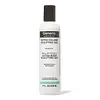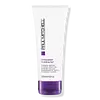What's inside
What's inside
 Key Ingredients
Key Ingredients

No key ingredients
 Benefits
Benefits

 Concerns
Concerns

 Ingredients Side-by-side
Ingredients Side-by-side

Water
Skin ConditioningPolyacrylamidomethylpropane Sulfonic Acid
Vp/Va Copolymer
Aminomethyl Propanol
BufferingCarbomer
Emulsion StabilisingPolysorbate 20
EmulsifyingPPG-5-Ceteth-20
EmulsifyingPropylene Glycol
HumectantDMDM Hydantoin
PreservativeButylene Glycol
HumectantParfum
MaskingIodopropynyl Butylcarbamate
PreservativeAloe Barbadensis Leaf Juice
Skin ConditioningTriethyl Citrate
MaskingBisamino PEG/PPG-41/3 Aminoethyl Pg-Propyl Dimethicone
PEG-12 Dimethicone
Skin ConditioningHedychium Coronarium Root Extract
MaskingWater, Polyacrylamidomethylpropane Sulfonic Acid, Vp/Va Copolymer, Aminomethyl Propanol, Carbomer, Polysorbate 20, PPG-5-Ceteth-20, Propylene Glycol, DMDM Hydantoin, Butylene Glycol, Parfum, Iodopropynyl Butylcarbamate, Aloe Barbadensis Leaf Juice, Triethyl Citrate, Bisamino PEG/PPG-41/3 Aminoethyl Pg-Propyl Dimethicone, PEG-12 Dimethicone, Hedychium Coronarium Root Extract
Water
Skin ConditioningPolyacrylamidomethylpropane Sulfonic Acid
Triethanolamine
BufferingCarbomer
Emulsion StabilisingPropylene Glycol
HumectantVp/Va Copolymer
Hedychium Coronarium Root Extract
MaskingBisamino PEG/PPG-41/3 Aminoethyl Pg-Propyl Dimethicone
Triethyl Citrate
MaskingEthylhexylglycerin
Skin ConditioningPEG-12 Dimethicone
Skin ConditioningLaurtrimonium Chloride
EmulsifyingAminomethyl Propanol
BufferingPolysorbate 20
EmulsifyingSodium Bisulfite
AntioxidantPhenoxyethanol
PreservativeParfum
MaskingHexamethylindanopyran
MaskingTerpineol
MaskingWater, Polyacrylamidomethylpropane Sulfonic Acid, Triethanolamine, Carbomer, Propylene Glycol, Vp/Va Copolymer, Hedychium Coronarium Root Extract, Bisamino PEG/PPG-41/3 Aminoethyl Pg-Propyl Dimethicone, Triethyl Citrate, Ethylhexylglycerin, PEG-12 Dimethicone, Laurtrimonium Chloride, Aminomethyl Propanol, Polysorbate 20, Sodium Bisulfite, Phenoxyethanol, Parfum, Hexamethylindanopyran, Terpineol
Ingredients Explained
These ingredients are found in both products.
Ingredients higher up in an ingredient list are typically present in a larger amount.
Aminomethyl Propanol is used to adjust the pH of products. It is also used as a base to create other organic compounds. Having a balanced pH is important for protecting your skin.
Aminomethyl propanol is safe to use in cosmetics up to 1%. It is soluble in water.
Bisamino PEG/PPG-41/3 Aminoethyl Pg-Propyl Dimethicone is a type of silicone.
Carbomer is a polymer of acrylic acid. Its main role is to create a gel consistency.
A high amount of carbomer can cause pilling or balling up of products. Don't worry, most products contain 1% or less of carbomer.
We don't have a description for Hedychium Coronarium Root Extract yet.
Parfum is a catch-all term for an ingredient or more that is used to give a scent to products.
Also called "fragrance", this ingredient can be a blend of hundreds of chemicals or plant oils. This means every product with "fragrance" or "parfum" in the ingredients list is a different mixture.
For instance, Habanolide is a proprietary trade name for a specific aroma chemical. When used as a fragrance ingredient in cosmetics, most aroma chemicals fall under the broad labeling category of “FRAGRANCE” or “PARFUM” according to EU and US regulations.
The term 'parfum' or 'fragrance' is not regulated in many countries. In many cases, it is up to the brand to define this term.
For instance, many brands choose to label themselves as "fragrance-free" because they are not using synthetic fragrances. However, their products may still contain ingredients such as essential oils that are considered a fragrance by INCI standards.
One example is Calendula flower extract. Calendula is an essential oil that still imparts a scent or 'fragrance'.
Depending on the blend, the ingredients in the mixture can cause allergies and sensitivities on the skin. Some ingredients that are known EU allergens include linalool and citronellol.
Parfum can also be used to mask or cover an unpleasant scent.
The bottom line is: not all fragrances/parfum/ingredients are created equally. If you are worried about fragrances, we recommend taking a closer look at an ingredient. And of course, we always recommend speaking with a professional.
Learn more about ParfumPEG-12 Dimethicone is a type of water-soluble silicone. It has skin conditioning and hydrating properties.
According to a manufacturer, this ingredient's stability is decreased by strong acid or alkali.
We don't have a description for Polyacrylamidomethylpropane Sulfonic Acid yet.
Polysorbate 20 is made by combining ethoxylation of sorbitan, ethylene oxide, and lauric acid. It is a mild cleansing agent, surfactant, and emulsifier.
As a surfactant, it helps collect dirt and oils for washing. Emulsifiers prevent oils and water from separating.
Polysorbate 20 also adds scent to a product. Since it is made using sorbitol, it has a sweet scent. Sorbitol can also be found in fruits such as apples and peaches.
The lauric acid used to create Polysorbate 20 is often derived from coconuts.
Polysorbate 20 may not be fungal acne safe.
Learn more about Polysorbate 20Propylene Glycol is an odorless, colorless liquid. As a humectant, it helps skin retain moisture. It also aids in delivering active ingredients.
Another role of this ingredient is preventing a product from melting or freezing. Propylene glycol also adds antimicrobrial properties to a product, elongating product lifespan.
This ingredient is considered an organic alcohol and commonly added into both cosmetics and foods.
Those with sensitive skin or conditions may develop a rash when using this ingredient.
Learn more about Propylene GlycolTriethyl Citrate comes from citric acid. It has masking, perfuming, and solvent properties. As a solvent, this ingredient helps disperse ingredients evenly in skincare.
One manufacturer claims this ingredient can:
According to perfume manufacturers, this ingredient is almost odorless but has a mild fruity, wine and plum scent. It can be used to mask the scent of other ingredients.
This ingredient can be plant-sourced or synthetic; it can naturally be found in cabbage and white wine.
Learn more about Triethyl CitrateWe don't have a description for Vp/Va Copolymer yet.
Water. It's the most common cosmetic ingredient of all. You'll usually see it at the top of ingredient lists, meaning that it makes up the largest part of the product.
So why is it so popular? Water most often acts as a solvent - this means that it helps dissolve other ingredients into the formulation.
You'll also recognize water as that liquid we all need to stay alive. If you see this, drink a glass of water. Stay hydrated!
Learn more about Water